Emilie Lee | Painting the American Prairie Reserve
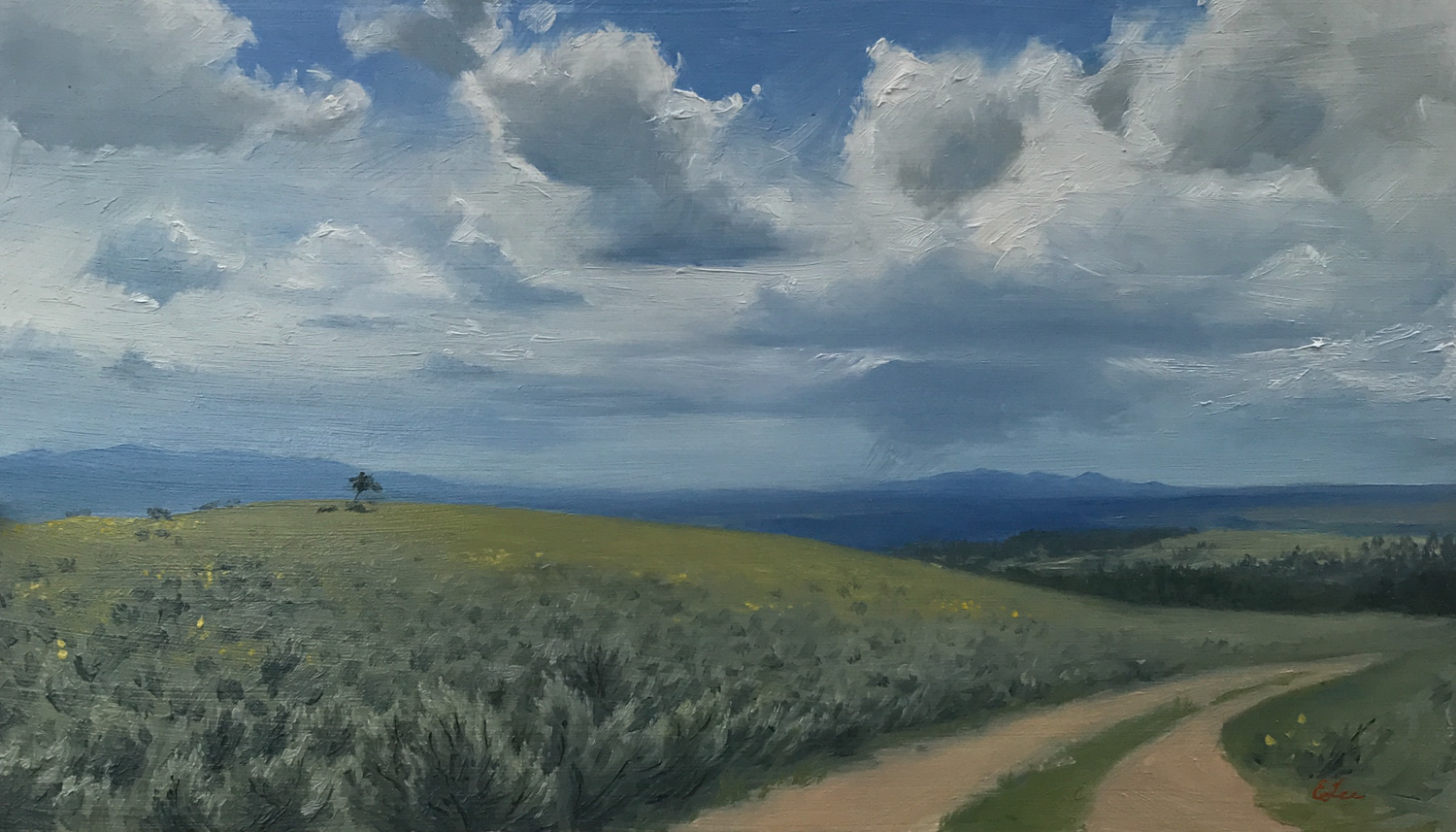
Emilie Lee | Painting the American Prairie Reserve
Painter
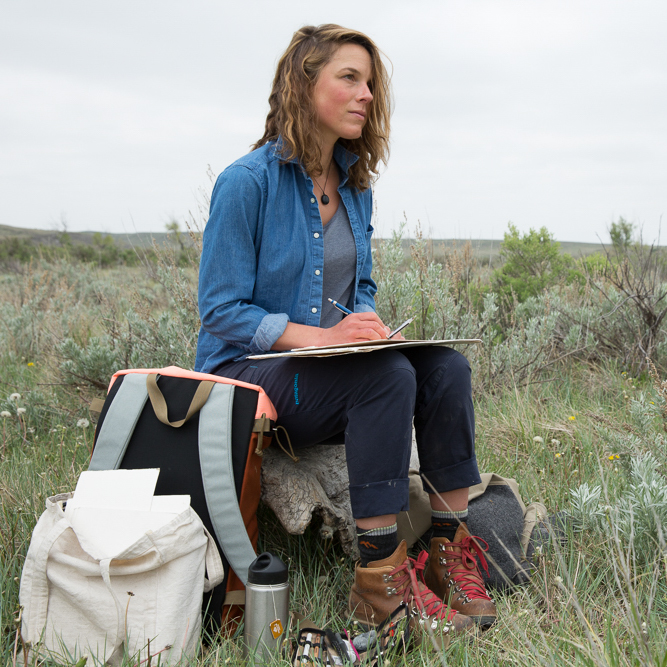
Emilie in her element – Photo by Eugenie Frerichs
Fifteen years ago, Emilie Lee was living in a school bus powered by veggie oil. She was climbing, dumpster diving, and making art that celebrated her dirtbag lifestyle. Her artwork and writing were published in Patagonia, the Alpinist, and Rock & Ice, but at a certain point she felt restless. That lead her to New York City’s academic painting scene. For eight years she dwelled in the city bettering her craft, but there was a point there too where she felt she wasn’t the best version of herself.
And then there was Montana. That’s where we find Emilie, two years into a painting project on the American Prairie Reserve – a remote area in North Eastern Montana that will one day be a 3.5 million acre protected wilderness.
We’re drawn to Emilie’s brush strokes and the textures of prairie grass in oil paint. But more than that – we are drawn to the story of place she tells in art and words. We’re drawn to the way she felt pulled from NYC to the wide open spaces of Montana, and what the extended project of painting on the prairies has been like.
Find out more, in Emilie’s words:
“I could never live out west again, the weather is too nice and I’d never get any work done. I’d probably waste all my time playing outside.” When I heard myself saying these words, I knew my transition from free-spirited dirtbag climber to jaded New Yorker was nearly complete. It had been seven years since I moved to New York City for an opportunity to study at the Grand Central Atelier.
The years flew by and soon I was no longer a student but a working (albeit struggling) artist – taking commissions, teaching, and buzzing around the city to galleries, museums, and networking events. Despite my accomplishments, a bitter attitude crept over me as I realized how much I had changed: I’d stopped climbing years ago and couldn’t imagine how anyone had the free time for such nonsense. As I ran my six-mile commute home from work at night on a Sunday in the freezing rain with fifteen pounds of groceries in my backpack, I felt smugly superior for saving money on subway fare AND getting a good workout in while not paying for a gym membership. I knew this wasn’t the life I had worked so hard for, and I knew this wasn’t the best version of myself. Something had to give. It was painting that got me into this situation, and it was painting that would get me out.
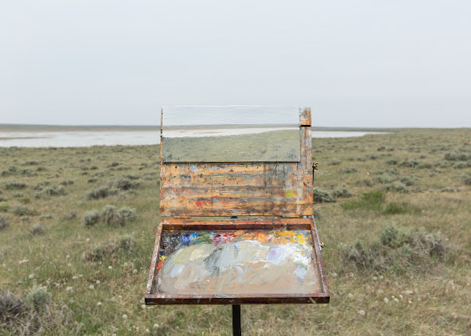
When I learned about The American Prairie Reserve… I was immediately obsessed with the idea of painting there.
When I learned about The American Prairie Reserve – an organization working to protect 3.5 million acres in Montana’s northern great plains, I was immediately obsessed with the idea of painting there.
Located north of the Missouri river and south of Saskatchewan, this massive territory feels forgotten by time. It spans an endless expanse of cracked, dry earth populated by sage brush, cactus, and wiry grasses, enduring blazing heat in the summer, forty below in the winter, debilitating “gumbo” mud when it rains, and incessant drying winds all year long.
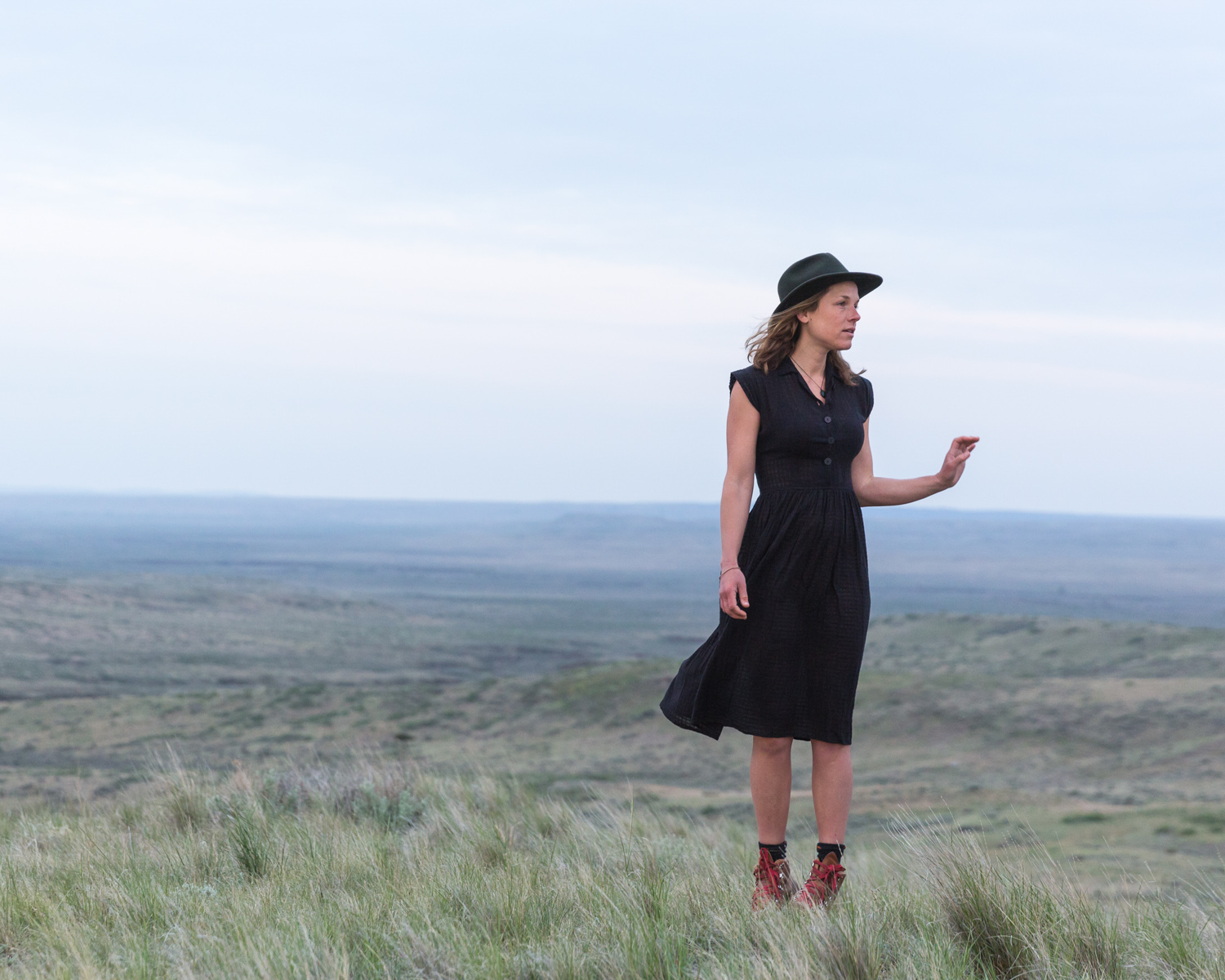
Emilie and the prairie wind – Photo by Eugenie Frerichs
Inhospitable as it is, a handful of tenacious ranchers live and work here, yet ninety percent of the native topsoil that is held together by fifteen foot deep root structures has never been plowed, making this one of only four remaining large-scale prairies in the world. Animal populations were severely reduced generations ago, but with wildlife-friendly ranching practices and the preservation of native plants, there is an exciting possibility for them to return.
Ninety percent of the native topsoil that is held together by fifteen foot deep root structures has never been plowed, making this one of only four remaining large-scale prairies in the world.
With this potential in mind, the American Prairie Reserve has been buying land when it comes on the market, merging it with leased government parcels, and taking down fences to facilitate rehabilitation. In 2005, 16 native bison were brought back to the prairie and today there is a herd of nearly 1,000 animals roaming the land, conjuring early accounts by Lewis and Clark who described a scene teeming with bison, elk, grizzlies, and wolves.
Learning all this from the confines of my life in New York, I was swept away by my imagination. I wanted to lose myself in this prairie, to let the wind whip through my hair and to feel the loneliness of being the only human in a thousand miles. I had never been to Montana, but I could imagine painting vast horizons in a minimalist palette, the simple juxtaposition of land and sky felt so enticing, and the fact that this was largest conservation effort in modern day America offered a deeper sense of purpose to the work I wanted to do.
I wanted to lose myself in this prairie, to let the wind whip through my hair and to feel the loneliness of being the only human in a thousand miles… and the fact that this was the largest conservation effort in modern day America offered a deeper sense of purpose to the work I wanted to do.
I spent the winter writing grant proposals, contacting sponsors, applying for artist fellowships, and articulating why it was so important that I make these paintings. I needed a plane ticket, a high clearance 4 wheel drive truck for one month, art supplies, and food. The partner I found was Adventurers and Scientists for Conservation – an organization that was collecting data on the Prairie Reserve’s wildlife population. With ASC’s help, I was on the prairie as soon as the snow melted that spring.
My first week was spent shadowing researchers from the Landmark crew. We hiked for hours through the night to count sage grouse dancing on their mating grounds as the sun rose, mapped prairie dog towns, and checked camera traps on game trails. In my first three days, I hiked 24 miles and asked a hundred questions about everything we saw. I wanted my paintings to be informed by more than just my usual observations of colors, lines, and shapes. When I learned the tender life-cycle of the gumbo primrose and the fierce strength of greasewood, these plants became poetic characters in my paintings and the landscape that seemed so empty and monotonous revealed itself as a world rich with stories.
So unchanged was this landscape, the time between present and past felt compressed.
Now and then I came across the dilapidated ruins of a cabin being swallowed by the grass, a poignant reminder that it wasn’t too long ago when the last bison was killed, Native people were confined on reservations, and the land was given away to starry eyed homesteaders. So unchanged was this landscape, the time between present and past felt compressed. Was it just yesterday that Chief Joseph led the Nez Perce through here, running for their lives with the US military in hot pursuit? It didn’t feel so distant to imagine Lewis and Clark stepping off their boat in disbelief at the vast herds of bison, or the ill fated residents of these rotting cabins, most of whom didn’t last through their first winter here.
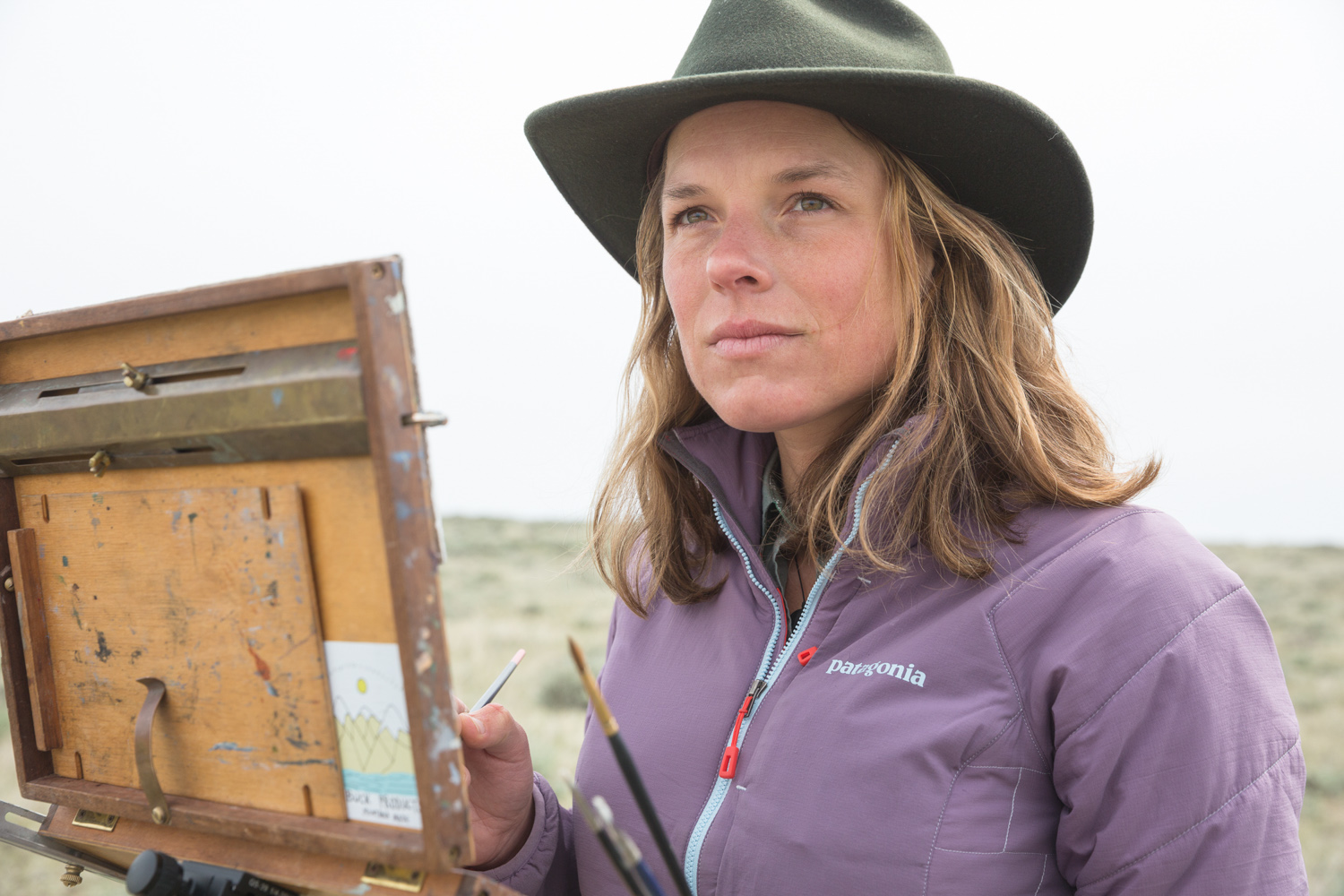
Photo by Eugenie Frerichs
- Photo by Eugenie Frerichs
Over the past two years, I visited three times and made over forty paintings on the American Prairie Reserve. I witnessed bison thundering across the plains, listened to elk bugling outside my tent, woke up to raging winds in the night, and the sweet song of meadowlark in the morning. I sat at the table with scientists, activists, journalists, donors, volunteers, artists, and native Montanans who inspired me with their passion and commitment.
When complete, this will be the largest nature reserve in the continental U.S. and home to all the native animals that once roamed the Great Plains.
At a time when there’s been so much heartbreaking news about the fate of wild places, it’s been even more inspiring to see tangible progress being made by the Prairie Reserve. In fact, on August 16, 2017 APR made their 26th land deal, protecting another 46,000 acres of crucial wildlife habitat in the region. When complete, this will be the largest nature reserve in the continental U.S. and home to all the native animals that once roamed the Great Plains. It will provide visitors an unparalleled opportunity to experience the history and heritage of this landscape in all it’s wild, hostile beauty.
During my time alone on the prairie, I fell into a daily rhythm of painting, trail running, eating, and sleeping. It was a simple life far from the chaos and noise of New York City, but remarkably more conducive to creativity.
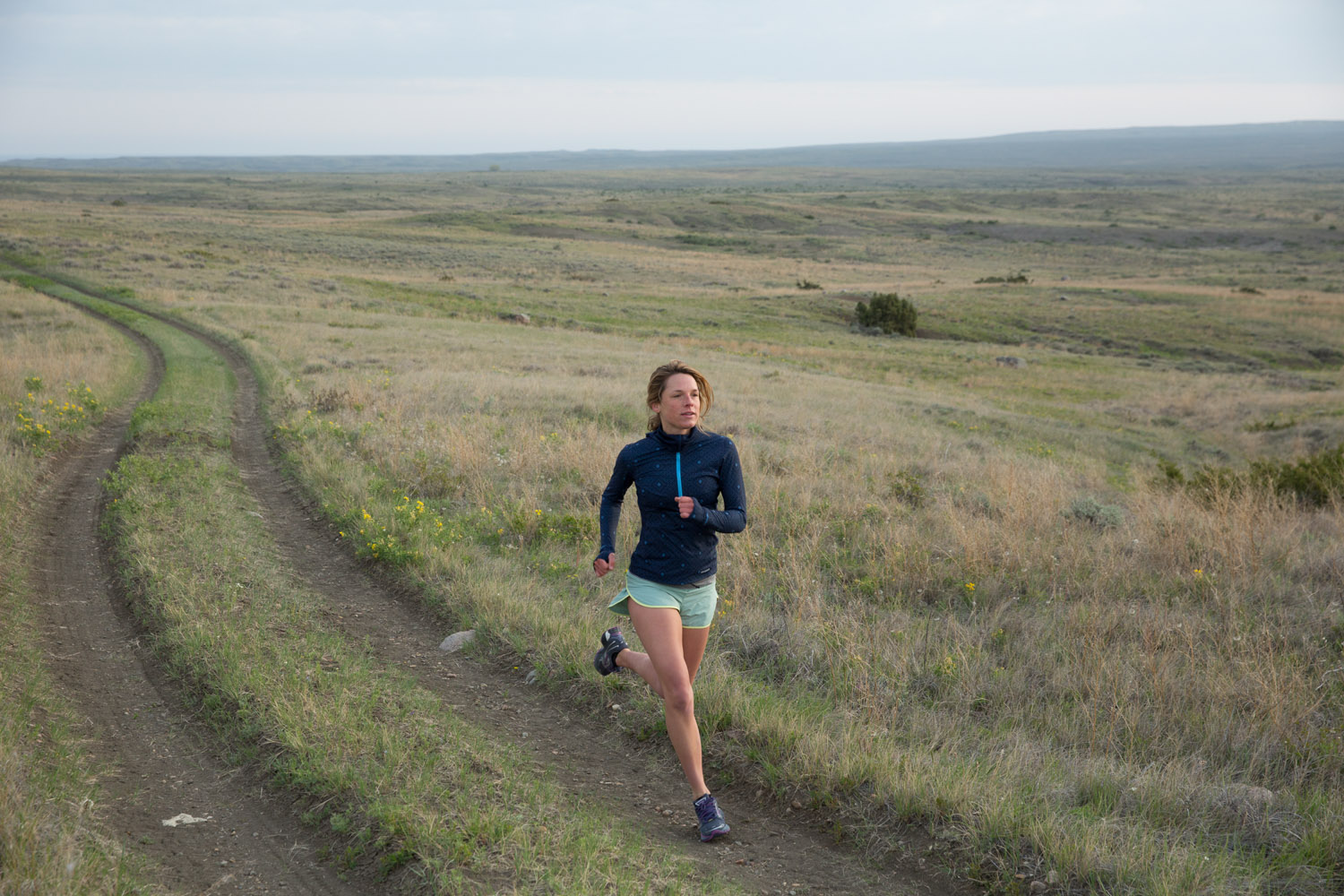
Photo by Eugenie Frerichs
Sometimes I made three paintings in a day, and the more I painted, the more I relaxed into a feeling of happy contentment. My hardened New York attitude fell away and I realized that I still thrive on the thrill of being a small human in a big landscape, humble in the face of nature’s infinite mysteries. It was a defining moment in my life and needless to say, it wasn’t long before I left New York and set my sights on a lifestyle that allows me the freedom to travel, paint, play outside, and share inspiring stories about our wild places.

All of the paintings Emilie made will be in a show at Old Main Gallery in Bozeman Montana opening November 4th 2017. 10% of proceeds will go to the American Prairie Reserve.
Photos courtesy of Emilie Lee and Eugenie Frerichs.
To see more of Emilie’s work visit emilielee.com, Instagram and read more on her Prairie project. Find more information about the American Prairie Reserve at americanprairie.org.
Do you find purpose in your work?








Beautiful paintings I can feel the wind off the grass when I look at them.
[…] September 2017, online: She Explores: Painting the American Prairie Reserve […]